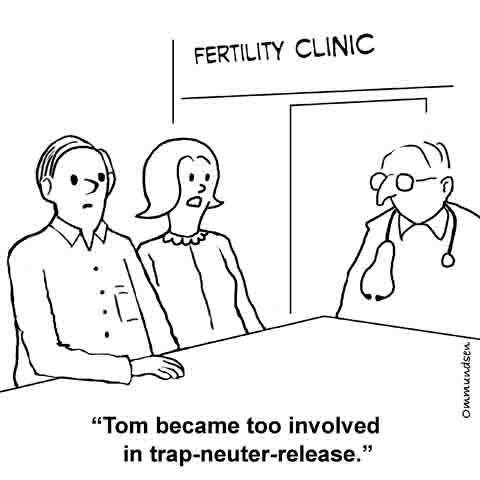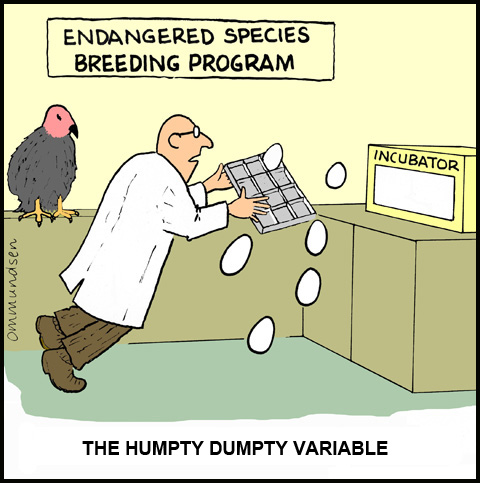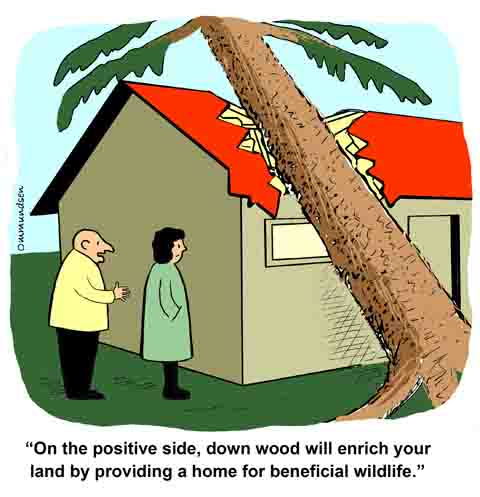GENERAL PRINCIPLES
Rhythm
The goal is to weave images smoothly into the rhythm of the presentation. The presentation should not grind to a halt with a prolonged silence during which the audience is expected to read a cartoon caption. Rather the images and narrative should support each other. Various approaches to maintaining rhythm are shown in the examples below.
Timing
Humour results from the unexpected, in this case presenting an unexpected image at a moment most likely to surprise the audience. Adequate preparation and rehearsal helps coordinate the correct timing of image display with the verbal presentation. The judicious placement of pauses (termed "beats") in the timing can be used to enhance the humour.
Set up
Audience expectations are set up by what precedes the image. A cartoon of a Martian inserted as a surprise into a sequence of slides of invasive species (weeds, rats, mussels, etc.) is humorous because the image is unexpected.
Word order and juxtaposition
Key words of the set up line or laugh line should be located at a point that will evoke the maximum audience reaction: “During our trip through the Crescent Creek Wetland we encountered a few mosquitoes.” [pause followed by image of a huge cloud of mosquitoes then pause for laughter]
This wording juxtaposes “few mosquitoes” with “many mosquitoes.”
Had the speaker said, "We encountered a few mosquitoes during our trip through the Crescent Creek Wetland,” the key words "few mosquitoes" may have been lost at the beginning of the sentence. Word order rehearsal is an important part of preparation.
Callbacks
Repeated use of an image (usually twice) in the presentation or use of a similar image can help reinforce a point and help build audience rapport. For example, saying, “Well, what have we learned from all this? What are we on the lookout for?” then showing the Martian image that had already been displayed twenty minutes earlier, lets the audience feel that they are privy to an inside joke.
Color or black and white?
Each cartoon must convey a message within a couple of seconds and this requires that it be uncluttered, clear and sharp, and immediately direct the viewer's eyes to the key imagery. Color is not necessarily better than black and white and in some cases can be distractive. Also keep in mind that some form of color blindness occurs in about one in every 75 people.
Image resolution
Images should be of adequate resolution (pixels in width) to match the screen resolution of the projector.
EXAMPLE 1: VISUAL SET UP OF AUDIENCE USING A PHOTOGRAPH
This example shows how two images in succession can create humour by using the first image to set up the audience.
SPEAKER: “Water is an important habitat for many wildlife species. What is this animal?” [pauses, then shows image]

[The speaker pauses on the image for about three seconds during which the audience may call out suggestions such as a whale or sea lion.]
[After the pause on the image, the speaker shows the next image, seen below. This animal was unexpected and likely will cause a laugh from the audience.]

EXAMPLE 2: VERBAL SET UP FOR A PHOTOGRAPH
SPEAKER: “You can enhance wildlife habitat by providing bird houses. What might you attract in your area?” [pauses for five seconds while audience members call out some bird names, then shows slide]
The audience thought of birds by association with "bird house." But note that the speaker did not say, "What birds might you attract?" The squirrel image is a humorous surprise.

EXAMPLE 3: CARTOON IMAGE SELF-EXPLANATORY
SPEAKER: “Wild ecosystems may be resilient and recover from disturbance as is seen in these examples.”
[The image is shown after the commentary, and likely after a series of photos of recovering ecosystems. The meaning of the image is obvious given the preamble. The audience will understand the joke whether or not the caption is read to them because it is integrated with the narrative.]

EXAMPLE 4: SPEAKER PARAPHRASES CARTOON CAPTION
SPEAKER: “You don’t want to get too involved in these cat-neutering programs or you may wind up like this guy, [shows slide, slight pause] at a fertility clinic.”
[Note that the words “fertility clinic” appear at the end of the sentence. Always leave the best to last and rehearse the word order.]

EXAMPLE 5: CARTOON DOUBLE PUNCH LINE
SPEAKER: “In wildlife captive breeding programs, things can go wrong.” [pauses, shows image, audience laughter, pauses] “This is the Humpty Dumpty effect.” [audience laughter]
[In this example the first humour point occurs when the audience sees the falling eggs. The second occurs when the audience hears the speaker paraphrase the caption.

EXAMPLE 6: PARAPROSDOKIAN -- SPEAKER READS CARTOON CAPTION ALOUD
In cartoons featuring verbal rather than visual humour, the speaker can read the cartoon caption to the audience, using the cartoon as a light-hearted case history. This works well, as such captions are often paraprosdokians, meaning that the latter part of the sentence is unexpected, as in this example.
SPEAKER: “Certainly environmental agencies may be short-staffed and overwhelmed. Just listen to the receptionist who answers the phone. This one is saying [displays image at this point], ‘Could you hold please? We’re dealing with an oil spill, a meltdown, a global extinction crisis, and the planet is warming’.”
[The audience is set up by the serious-sounding topic, and by the oil spill and meltdown, the humour point arriving with the mention of the global problems.]

EXAMPLE 7: CARTOON EMPLOYED TO PROMOTE EDUCATIONAL DISCUSSION
SPEAKER: “Eventually trees fall to the ground. Although this may have adverse effects [shows image] down wood left on the ground can have ecological value. What organisms may benefit, and how? ”
At this point, an audience (especially students) can brainstorm various natural processes in ecological cycling and natural history. Suggestions may include the value of down wood in creating shade, cover, foraging sites, nest sites, basking sites, bridges, travel corridors, moisture retention, nutrient cycling, and natural compost. The audience may suggest a variety of life forms that may utilize down wood including mushrooms, birds, turtles, spiders, lizards, bats, shrews, weasels, salamanders, ferns, herbs, lichens, mosses, etc. And the natural composting of down wood provides a substrate for soil life including nature-friendly bacteria, millipedes, crustaceans, molluscs, mites, nematodes, and fungi.

To see more cartoons, visit the ECOLOGY CARTOONS web site.
All images copyright 2004, 2005, 2006, 2007, 2008, 2009, 2010, 2011, 2012 Peter Ommundsen
To contact Peter Ommundsen click
HERE
or email cartooning at-sign shaw dot ca